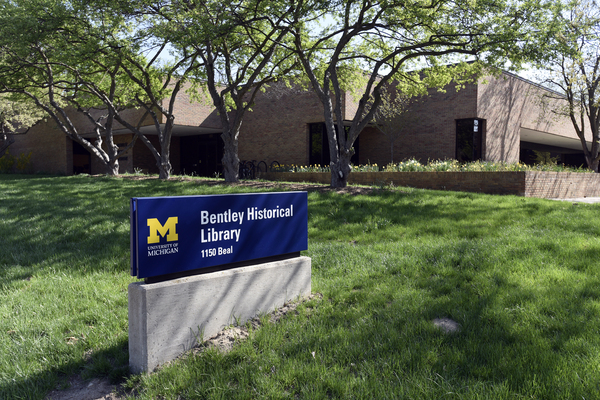
Search Constraints
Start Over You searched for: Repository University of Michigan Bentley Historical Library ✖ Remove constraint Repository: University of Michigan Bentley Historical Library Places Pontiac (Mich.) ✖ Remove constraint Places: Pontiac (Mich.) Formats Postcards. ✖ Remove constraint Formats: Postcards.Search Results
0.5 linear feet
The Crawford family collection documents the experiences of Harry M. Crawford as a soldier during the Spanish-American War and World War I. It also contains information about the home front in Pontiac, Michigan during those two wars. There are few accounts of battles in these letters; rather the strength of the collection lies in the abundant descriptions of daily life both in the army and in Pontiac during this time period.
The correspondence, which is the heart of this collection, is chronologically arranged and divided into Spanish-American War correspondence (1898) and World War I correspondence (1917-1919). The Spanish-American War correspondence is further divided into correspondence from Harry Crawford to his family in Pontiac and correspondence from family and friends to Harry Crawford. Harry Crawford's letters to his family began in May 1898 when he mustered in at Camp Eaton, west of Pontiac. Crawford continued to write home, on a near-daily basis, from army camps in and around Tampa, Florida. The letters end in September when he returned to Michigan. Most of Harry Crawford's letters pertain to the daily routines of army life during encampment and rumors about the progress of the war. While Harry Crawford was generally supportive of United States war aims, he was critical of the capture of the Philippines (see his letter of August 10). The correspondence from family and friends to Harry Crawford contains information on a wide range of daily activities in Pontiac at the turn of the century. Reactions to the war were supportive on the home front (see especially the letters of G.G. McDonald from July 4 and of George Crawford from July 31). Advice on the art of soldiering from Harry's uncle, Walter Crawford (a Civil War veteran), may be found in a letter dated July 3.
The World War I correspondence is almost exclusively from Harry Crawford. Few letters from home survived but some information about Pontiac during the war, such as the impact of the influenza and the lack of coal during the winter, may be gleaned from Harry's responses to letters from his family. Harry Crawford's letters began in August 1917 from Fort Sheridan in Illinois. They continued through 1918, from France, and concluded in April 1919 when he returned to the United States. Harry Crawford wrote, on average, two to three letters per week. While Crawford spent some time on the front lines, descriptions of actual battles are few. Many of the letters describe the camaraderie with fellow soldiers and several tell of his anticipation of combat. A number of other letters pertain to the material conditions of his daily life (food, lodgings, and clothing). He also described the destruction wrought on the French countryside. Since his letters were censored, Crawford omitted references to specific places in his letters. Some of this specific information is included in a letter to his brother, George Crawford, following the Armistice (see his letter of November 24, 1918).
7.4 linear feet (in 10 boxes; over 5000 postcards)
The Penrod/Hiawatha Company collection is mainly comprised of postcards, although some supplemental photographic items directed toward tourists is also included. The postcards, numbering more than 5,000, primarily are of the Michigan landscape and its towns and cities, covering every region of the state. Typical postcard themes dominate, particularly natural scenery, outdoor recreation, and shopping districts. The postcards date from the 1950s through the opening decades of the twenty-first century, although very few display copyright dates. The collection is divided into the following series.
- Non-Postcard Items (calendars, brochures, booklets): Box 1
- Non-Penrod/Hiawatha Postcards: Box 2
- Penrod/Hiawatha Postcards, 1970s-1990s: Boxes 2-5
- Penrod/Hiawatha Postcards, mid- to late 1990s: Boxes 5-6
- Penrod/Hiawatha Postcards, late 1990s-2000): Boxes 6-7
- Penrod/Hiawatha Postcards, 2001-2004: Box 8
- Penrod/Hiawatha Postcards, 2005-2014: Box 9
- Oversize and miscellaneous: Box 10
As batches of postcards are received every years, it was decided to arrange the items in blocks of time according to the date of their accession. Thus for the researcher interested in a specific city, it will be necessary to examine the listing for each of the series.
Penrod/Hiawatha Company postcard collection, 1950s-2017
7.4 linear feet (in 10 boxes; over 5000 postcards)
14.4 linear feet (in 15 boxes) — 1 oversize folder
The Michigan Historical Collections postcard collection contains picture postcards of Michigan scenes. The collection was brought together by MHC staff. The postcards depict a large number of Michigan communities, with the largest number of cards relating to Ann Arbor, the University of Michigan, and Detroit.
The postcards are arranged by the name of the town shown in the picture. In cases where names have changed, or for rural places that might be identified with several surrounding towns, the postcards are filed according to the name used on the card. For instance, postcards of the Irish Hills region can be found under that name as well as under the nearby towns of Brooklyn and Onsted.
Outsize postcards are located in Box 12, and a few postcards too large for that box are located with the medium sized photographs in UCCm.